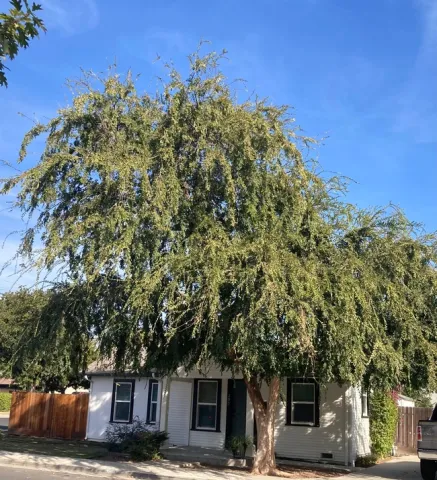Last season's torrential winter rains provided a much-needed relief from 20 years of drought. However, Central Valley home gardeners deal with the effects of drought every summer because, even with regular irrigation, extremely high temperatures during our long, rainless summers create drought stress conditions.
Large mature shade-producing landscape trees and bushes have been weakened by years of drought. Summer drought speeds up the normal fall process of slowing vegetative growth and also leads to smaller leaves and early leaf drop on deciduous plants. Leaves make food for trees. Trees and bushes with fewer, smaller leaves in fall have fewer stored resources and less food for next year's growth. Small, fine roots die and plants are unable to draw up and store enough water and nutrients to overwinter well and to quickly regain their vigor in spring.
Check soil moisture levels now in several places underneath large tree and bush canopies, especially those that have not received at least monthly deep irrigation during the summer months. The top few inches of soil near trees and bushes in lawn areas may be moist from sprinkler water. Sprinkler water generally only penetrates to a depth of four inches, but try to check moisture levels at least 12 inches deep using a shovel or trowel.

Deep irrigate large, mature landscape trees and bushes in early fall to a depth of 18 inches before dormancy to help them better tolerate cold or below freezing temperatures. Continue to provide monthly slow deep irrigation throughout the winter months unless rainfall from atmospheric rivers provides sufficient water to soak the soil.
Wet soil around the roots provides better insulation against cold temperatures than dry soil. During the next few weeks closely examine your and your neighbors' large trees and bushes for branch dieback to prevent damage from falling dead branches during winter storms. Winter pruning of deciduous trees and bushes should wait until after leaf fall, but dead wood can be removed at any time.
If dead branches are large or higher than 15 feet it's best to hire a certified arborist to do the work. Many large landscape trees were blown over during last year's violent windstorms. Root systems of surviving trees may have been compromised or broken from the soil from high winds. Changes in the angle of the tree trunk as it begins to tip may not be obvious.
Check the soil under canopies for evidence of root uprise with special attention to the northwest and western sides; our winter storm winds generally come from the northwest or western direction. If you see signs of tree tipping consult a certified arborist who can determine whether the tree is unsafe and should be removed before the winter storms.
Newly planted trees and large bushes should be properly staked to help them stand up to strong winds. Use strong poles and cushioned ties on the trunk and position the poles or stakes at the edge of the rootball on the northwest or west side. Most trees and bushes have a heavier side with more or bigger branches. Check that the heaviest side of the tree or bush is planted to back up to the northwest or west. Replant if necessary to correctly balance the new tree against the force of winter winds.


